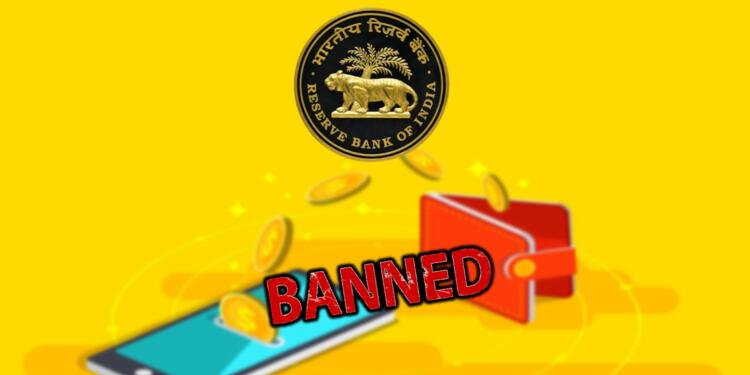India just pipped Britain to become the 5th largest economy in the world. It became possible only because of increased business activity, thanks to the easy availability of loans to MSMEs and even big business houses. The NPA crisis is a thing of the past. However, there is another crisis knocking at our doors. It is the inundation of our fintech sector with “instant loan apps”.
RBI tightening noose on instant loan apps
According to the reports available in the public domain, RBI has decided to prepare a list of legal loan apps in India. The decision was taken in a meeting chaired by Nirmala Sitharaman, our Finance Minister. The gravity of the issue can be gauged from the fact that the meeting about saving 1.4 billion Indians from fake loan apps involved high dignitaries such as Finance Secretary T. V. Somanathan, Economic Affairs Secretary Ajay Seth, Revenue Secretary Tarun Bajaj, Financial Services Secretary Sanjay Malhotra, MeitY Secretary Alkesh Kumar Sharma, and senior RBI officials.
In the meeting, Nirmala Sitharaman expressed particular concern about the impact of illegal loan apps on the poor and vulnerable section of the population. The main concerns affecting the Finance Minister are exorbitantly higher interest rates and hidden charges that people are unable to comprehend due to lack of education and time. She also expressed her reservations about these apps being used for money laundering, tax evasion, breach/privacy of data, misuse of unregulated payment aggregators, shell companies and defunct NBFCs.
Now, RBI will prepare a list of applications which are legally allowed to offer loans and it will then be handed over to the Ministry of Electronics and Information Technology (MeitY). On its part, MeitY will hand over the list to owners of play stores and they will be asked to take down other apps which are in the same category but have not been whitelisted by India’s Central Bank.
The historical legacy of poor credit disbursal
Historically, credit offtake has been one of the biggest problems for both governments and common citizens. For the most part of our existence as a politically independent nation, citizens and industrialists both had their qualms about taking credit from banking institutions, industrialists did not take it due to red-tapism diluting their chances of earning profits and citizens were troubled due to bribery & commission cuts of middlemen. Also, paperwork was too cumbersome for a common citizen to engage with bank officials.
Jan Dhan Yojana made banking accessible
LPG reforms did pave the way, but things were too slow by the end of 2014. Then PM Modi came and launched his financial inclusion initiative called Jan Dhan Yojana. He wanted every citizen of the country to save every penny in their personal bank accounts. That is why he made it easier for them to open bank accounts for anyone above 18 years of age.
By the end of 2014, 53 percent of Indians had personal bank accounts. This number jumped to 80 percent by the end of 2017 and it is increasing further despite Covid hurdle. The uneducated section of society, people out of the labour force and women were the biggest beneficiaries. As of April 2022, Indian banks had liquidity of 1.7 trillion INR only on the back of Jan Dhan Accounts. Easier saving meant that people now had more leverage to spend money. Indians were quick to utilise these savings towards opening small businesses.
The psychological side of an increase in access to banking
To compensate for the shortcomings in savings, the Modi government launched various schemes such as MUDRA Yojana, and Credit Linked Capital Subsidy for Technology Upgradation among others. Growth occurred and as a result, inequality increased. Now certain Raju who used to work with a Shyam on a monthly salary of Rs 30,000 now started to earn double the amount, thanks to him opening his own business.
This increased his income and this is where Raju felt the need to upgrade his living standard and this is exactly where instant loan companies made their mark. While banks were busy recovering from NPAs, they were quite apprehensive about disbursing new loans. In that circumstance, digital lending came off as a saving grace for people. While in the year 2012, Indians availed only $9 billion worth of digital loans, the number took a near 12-fold spike in 7 years. Between two cricket world cup cycles, digital lending of Indians went up from $9 billion to $110 billion. This number is estimated to touch $350 billion in 2023.
Majorly digital loans are taken for a short period of time. In fact, it saw considerable increase during Covid times. In 2020, the year in which Covid struck the world, Indians availed loans with 30 days tenure in humongous proportion. A total of 0.9 lakh crore of short term loans were disbursed by Indian FinTechs and NBFCs. The disbursal of short-term loans indicates that people are more inclined towards getting instant dopamine hits rather than building strength-to-strength. Students end up taking credit for their birthday parties in clubs and canteens, while housewives end up taking loans for Kitty parties.
Entry of bad faith actors
Proclivity towards instant gratification is the reason why bad faith actors have entered into this segment. Not every fintech and not every NBFC operates on moral and ethical grounds. In fact, as it turns out that most of them do not have any ethical principle, other than profit of course. Time and again RBI cancelling NBFC registration keeps dominating headlines. In July this year, a report involving massive involvement of Chinese funds in NBFCs and FinTechs had also sent shock waves in the nation.
Mechanism of lending apps
What a lot of fintech companies do is that they start to disburse loans through nefarious means. They either do it through playing around the rules of earlier approved terms of lending or they float new apps in the market. For instance, suppose Shashi Ranjan is in desperate need of Rs 10,000. But his credentials among family and friends are down. Over a period of time, he has also destroyed his credit score by not paying back legitimate loans on time, so they are also reluctant to give him a loan again.
Now, Shashi searches for instant loans on a lending app. The lending app collects his request but can’t disburse it due to his low credit score. But they can send ads of other applications to Shashi’s phone. Whatever Shashi wants is available on this app. The application does not compel him to submit his Aadhar, Pan and other intrinsic details. All they ask for him is his phone number and current address. He readily hands over these details to them and the loan is disbursed.
Payback time is humiliation time
While Shashi is busy spending the money, the instant loan application is preparing to collect it. Its preparation includes spying into his phone, collecting call record data, and figuring out his frequent call details. The intriguing thing is that they do it by asking users to allow them access for the sake of prevention of fraud and other stuff. In other words, the problem here is not that they are doing illegal activities. Instead, the main problem is that they are doing it through illegal means.
Now when the consumer does not repay loans in time, they regularly call him to harass and use soft coercion. In case the loan is not paid back in one or two days, the person is subjected to social shame. Their friends and relatives are called and given a detailed outlook of his financial condition. The final step is that of threat calls. Loanee is threatened that the recovery agent will snatch every ounce of his blood to recover money.
Official numbers around the scam
According to a report by The Economic Times, total 6 cases of suicides have been traced to loans from these apps. Number of suicides in official figures is in no way indicative of the on-ground reality. Why am I saying this? Well, just like every other crime statistic in India, this number also seems to be affected by under-reporting. In just one city of Hyderabad, 250 billion transactions have taken place within the first 8 months of this year only. Minimum amount involved in transaction was Rs 2,000 while maximum was Rs 20,000.
Apparently, Hyderabad is just the tip of the iceberg. Recently, the Enforcement Directorate found that instant loans worth Rs 4,000 crore were disbursed by the nefarious partnership of FinTech firms and NBFCs.
FinTechs, NBFCs and China
What these NBFCs used to do was that they used to lend their RBI-issued licence to fintech companies for a share of profit ranging from 0.5 to 1 per cent. The most ghast fact about this investigation is that Chinese companies were found to be funding these fintech firms.
Fintech companies provided total disbursement amounts which were given to NBFC to distribute. The lending NBFC was getting paid a hefty sum without investing anything since the burden of recovery was on Fintech firms. NBFC deducts its fee from the loan amount itself. Moreover, in the name of processing charges, customers were forced to give another 15-25 percent of total loan at the time of disbursal itself. ED found that out of 4,000 crore these companies distribute, they had already recovered 700 crores before even transferring money to the customers, all in the name of transaction fees.
Actions by app store and authorities
As soon as news about ED action on the instant loans sector came out, Google felt compelled to shelve itself from scrutiny. It instantly announced that in the first 6 months of this year, the play store had banned 2,000 applications. On the regulatory side, India’s Central Bank already has a ready list of 600 such illegal apps, which they had prepared in November 2021.
But the tech world is not static and within 10 months, hundreds of such apps have marked their presence on respective play stores. Reports of the Modi government banning 300 of those have also emerged. Even offices of Paytm, CashFree and RazorPay were also raided. But their China connection ended up hogging the limelight rather than their impact on the average Indian.
Can undo the gains made in economy
It has taken us too long to recover from the NPA crisis. The policy paralysis had weakened our financial system so much that it took nearly 7 years for Banks to free themselves of the systematic burden. In July this year, gross NPA was reported at 5.9 per cent, a 6-year low with the prediction of improvement.
Demonstrably, income of banks have now reached a level of stability and they have started to earn more profits. Now banks are not reluctant to lend which is manifested in their credit numbers as well. The problems related to instant loan apps have the potential to kill this enthusiasm and impact India’s economic growth.
Need to sustain trust
India is striving towards becoming a $30 trillion economy in a few decades, problems are also knocking its doors. Other than policy issues, one big problem which can stop us from achieving this dream is that of trust. Yes, financial systems are built on trust. Without trust, it is next to impossible to carry out transactions, no matter how big or small they are.
The last thing our policymakers would want is the impact of low trust in the lower income segment of the population starting to affect credit growth.
Support TFI:
Support us to strengthen the ‘Right’ ideology of cultural nationalism by purchasing the best quality garments from TFI-STORE.COM































